The development of modern telecommunications from the first electrical telegraph over the last 150 years is the result of the work of thousands of scientists, engineers and even researchers from quite different walks of life. Few of them were solely responsible for the invention for which they are famous, most major inventions being the culmination of the work of many individuals.
Arthur C. Clarke
 Born
Born: Minehead, England, 16 December 1917
Died: Colombo, Sri Lanka, 19 March 2008
Twelve years before the first artificial earth satellite Sputnik-1 was launched by the USSR, Arthur C. Clarke proposed in an article published in Wireless World in 1945, the use of geostationary satellites for world-wide radio coverage. These have since become a very significant part of the world's communication systems. Clarke's other inventions include the use of satellite platforms for earth observation, and the manoeuvrable solar sail for low-acceleration interplanetary flight.
Bardeen, Brattain and Shockley
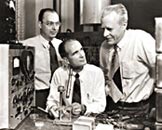
The transistor was invented in 1947 by three physicists, John Bardeen, Walter Brattain and William Shockley working at the Bell Laboratories in the United States. Transistors can detect, amplify and rectify currents and switch them on and off. They are small, cheap and use very little energy. These properties have made it possible to develop electronic switching of communications. Without them
there would be no satellite communications. Transistors have made possible modern computers, pocket calculators, hearing aids, portable radios and casette players, high-fi systems and a host of their equipment.
Samuel Morse
 Born
Born: Charleston, Massachusetts, United States, 27 April 1791
Died: New York City, 2 April 1872
Samuel Finlay Breese Morse was the inventor of the electromagnetic recording telegraph and the developer of the code of dots and dashes known as the Morse Code. In his early years Morse's interests lay principally in the arts. It was not until 1832, at the age of 41, that he completed the drafts of his electrical telegraph which was first publicly demonstrated in August 1837. Morse applied for, and received, a United States Patent, but his petition to Congress for a credit to defray the costs of setting up an experimental public telegraph was not accepted until 1843. It was finally on 24 May 1844 that Morse transmitted his first message from Washington D.C. to Baltimore, a distance of some 60 km. Although telegraphy has now largely been replaced by more modern telecommunication services, Morse's original concept is still in use and the Morse Code still remains a universal standard for sending messages.
Alexander Bell
 Born
Born: Edinburgh, Scotland, 3 April 1847
Died: Baddeck, Nova Scotia, 2 August 1922
"Mr. Watson, come here, I want you". These words, pronounced by Alexander Graham Bell on 10 March 1876, in Boston, United States, formed the first intelligible sentence to be transmitted over the telephone. Although a number of other inventors had proposed systems for the electrical transmission of sounds over distance, Bell was the first to be awarded a patent for his invention. Only two years later, on 25 March 1878, he made the following prediction: "It is conceivable that cables of telephone wires could be laid underground or suspended overhead communicating by branch wires with private dwellings, country house, shops, factories etc., uniting them through the main cable with a central office where the wires could be connected as desired establishing direct communications between any two places in the city. Such a plan as this, although impracticable at the present moment, will, I firmly believe, be the outcome of the introduction of the telephone to the public. Not only so, but I believe, in the future, wires will unite the head office of the telephone company in different cities, and a man in one part of the country may communicate by word of mouth with another in a different place." Bell was only 29 when he invented his telephone but he went on to make other inventions in communications as well as in aeronautics. Throughout his life he also laboured to help the deaf.
Guglielmo Marconi
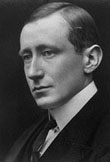 Born
Born: Bologna, Italy, 25 April 1874
Died: Rome, 20 July 1937
As a student, Guglielmo Marconi was particularly interested in magnetism and the application of Hertzian waves. On 2 June 1896 he applied for his first patent concerning radio. A highly practical and enterprising man, Marconi was quick to commercialize his discoveries and, in July 1897 he founded in London the first company for wireless telegraphy. In 1899 he managed to transmit by radio a message across the English Channel and, in 1901, he sent signals across the Atlantic Ocean from Cornwall, England to Signal Hill, Newfoundland. By 1907 a transatlantic wireless service had been established and in 1909 he was awarded the Nobel Prize for physics. In 1924 he discovered skywave transmission which enabled him to offer a world-wide communication service. Throughout his life, Marconi dedicated himself to the expansion of wireless telegraphy and a total of nearly 800 patents were awarded either to him or the companies he directed.
Aleksander Popov
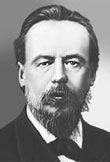 Born
Born: Urals, USSR, 16 March 1859
Died: St. Petersburg, USSR, 13 January 1906
Aleksander Stepanovich Popov was a lecturer in physics at the Russian Imperial Navy's school at Kronstadt near St. Petersburg. After Hertz had demonstrated the existence of electromagnetic waves Popov experimented with ways of detecting them by a receiver. His experiments were demonstrated on 7 May 1895 to the Russian Physics and Chemistry Society and reported a few days later in the Kronstadtskii Vestnik. The report concluded that the aim "is to show that it is theoretically possible to transmit signals over a certain distance without the use of conductors, in other words, after the fashion of visual telegraphy but with the aid of electrical radiations".
Almon B. Strowger
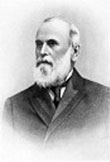 Born
Born: near Rochester, NY, 1839
Died: 1902
Almon B. Strowger invented an automatic telephone exchange in 1889. A funeral undertaker, Strowger suspected that, by design or by error, local telephone operators deviated his business calls to rival firms. He therefore had the idea of switching telephone calls automatically and his work on this idea led to the installation of the first commercial automatic exchange in the world at La Porte (Indiana) in the United States.
Sergei Korolev
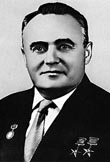 Born
Born: Zhitomir, USSR, 30 December 1906
Died: Moscow, 14 January 1966
From 1947, Academician Sergei Pavlovich Korolev directed the design of rockets in the USSR which led to the launch of Sputnik-1, the first artificial earth satellite, on 4 October 1957. He was responsible for directing the development of many more recent rockets. Rocket technology is essential for the launching of artificial earth satellites which play a very important part in modern telecommunications. Korolev also directed the development of a number of satellites including the Molniya-1 series of telecommunications satellites.
Heinrich Hertz
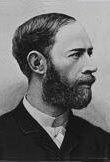 Born
Born: Hamburg, Germany, 22 February 1857
Died: Bonn, 1 January 1894
Heinrich Hertz discovered electromagnetic waves in 1887-1888 at the University of Karlsruhe, confirming the theory of James Clark Maxwell who had predicted their existence. Hertz's discovery is the basis for radio technology and for the later development of broadcasting and television.
Alessando Volta
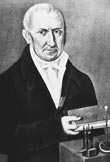 Born
Born: Como, Italy, 18 February 1745
Died: Como, 5 March 1827
Alessando Volta studied the generation of electricity by chemical action. He invented the first electrical cell, the precursor of the electrical battery which was for many years the principle power supply for telecommunications. In 1777 he visited Saussure in Geneva and Voltaire at Ferney.
Nikola Tesla
 Born
Born: Smiljan, Croatia, 10 July 1856
Died: New York City, 7 January 1943
Nikola Tesla worked on alternating currents and high frequency radio waves. He demonstrated the transmission of electrical energy without wires and, in 1899, constructed an emitting station in the state of Colorado, (United States) from which he was able to receive 1,000 km away clear radio signals. He invented a system of inductive coupling between two circuits. He was granted over 100 patents on subjects such as the construction of electrostatic capacitors, the insulation of electrical conductors, a frequency meter, etc.
Emile Baudot
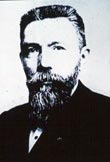 Born
Born: Magneux, France, 11 September 1845
Died: Sceaux, France, 28 March 1903
Emile Baudot dedicated his life to the development of a fast-printing telegraph. After successively improved versions, he demonstrated at the International Exhibition of Electronics a perfected model which could transmit six simultaneous messages. The Baudot system was used throughout the world for terrestrial and undersea links for over 70 years.
